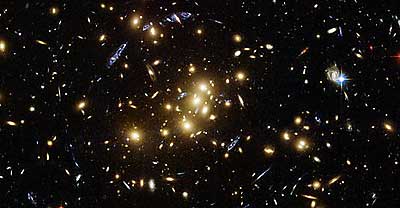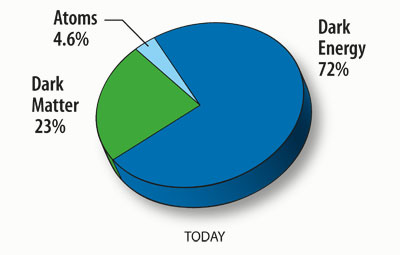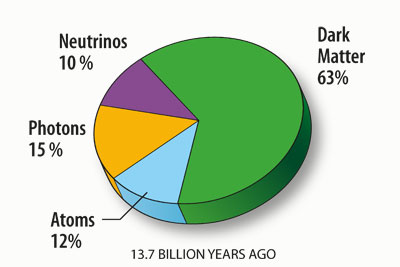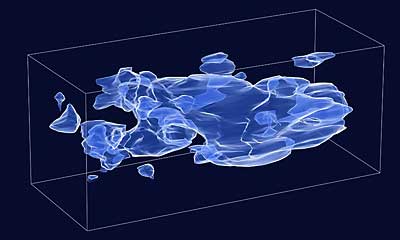•
If there was no dark matter, we wouldn’t be here.
— Professor Wolfgang Rau (Kingston, Canada)
Re-reading Philip Pullman’s His Dark Materials trilogy never fails to drive me to my “Tor/Dark matter” e-folder.
And there’s a lot up with dark matter these days…
The Cryogenic Dark Matter Search
Sounds like the title of a creepy SF novel: we just know the search for dark matter will end badly for our likable protagonist, so diligent and courageous.
A little background to recent dark-matter reports is always useful:
The Cryogenic Dark Matter Search (CDMS) is a series of experiments designed to directly detect particle dark matter in the form of WIMPs [weakly interacting massive particles].
Using an array of semiconductor detectors at millikelvin temperatures, CDMS has set the most sensitive limits to date on the interactions of WIMP dark matter with terrestrial materials.
The first experiment, CDMSI, was run in a tunnel under the Stanford University campus. The current experiment, CDMSII, is located deep underground in the Soudan Mine in Minnesota.
I grew up only a few miles from the Sand Hill entrance to the Stanford Linear Accelerator. I thrill to know the SLAC, among other projects, plays host to the dark-matter, early-universe probing GLAST project.
Hints of Dark Matter

Late last year it was reported that
An international team of physicists working in the bottom of an old iron mine in Minnesota said Thursday that they might have registered the first faint hints of a ghostly sea of subatomic particles known as dark matter long thought to permeate the cosmos.
The operative phrase is “might have”—possible detection, but no proof. The abstract for Dark Matter Search Results from the CDMS II Experiment reads (italics mine):
Astrophysical observations indicate that dark matter constitutes most of the mass in our universe, but its nature remains unknown.
Over the past decade, the Cryogenic Dark Matter Search (CDMS II) experiment has provided world-leading sensitivity for the direct detection of Weakly Interacting Massive Particle (WIMP) dark matter.
The final exposure of our low-temperature Ge particle detectors at the Soudan Underground Laboratory yielded two candidate events, with an expected background of 0.9 ± 0.2 events.
This is not statistically significant evidence for a WIMP signal.
The combined CDMS II data place the strongest constraints on the WIMP-nucleon spin-independent scattering cross section for a wide range of WIMP masses and exclude new parameter space in inelastic dark matter models.
Tarek Saab, a University of Florida assistant professor participating in the Cryogenic Dark Matter Search II, or CDMS II, experiment says:
Many people believe we are extremely close — not just us, but other experiments,” Saab said. “It is expected or certainly hoped that in the next five years or so, someone will see a clear signal.
If the particles are confirmed by tests at other detectors:
[A]stronomers are zeroing in on the identity of the invisible material that accounts for 25 percent of the universe and determines the architecture of the visible universe.
Dark Stars: The Black Hole – Dark Matter Connection

Black holes are common today, but were thought to be rare in the early universe.
Evidence suggesting black holes were not so scarce 14 billion years ago has puzzled astrophysicists. Now it seems dark matter may be at the heart of the puzzle.
Katherine Freese and her co-workers at the University of Michigan suggest:
[W]hen the universe was just 80 million to 100 million years old, as protostellar clouds of gas tried to cool and shrink, their gravity would have drawn in neutralinos that annihilated one another, unleashing energy that would have created the first stars.
They dub these objects “dark stars,” fueled by dark matter rather than nuclear energy as in normal stars.
While dark stars are still hypothetical, as Brian O’Shea of Michgan State says, “If dark stars do exist, that would be incredibly cool.”
[ More ] [Also: Supermassive Black Holes ]
•
Einstein, Dark Matter, Dark Energy—and Disturbed Scientists
•

•
Reported in March, a recent analysis of 70,000 galaxies suggests Einstein got it right 95 years ago: the universe plays by the rules set forth in his General Theory of Relativity.
This analysis also suggests that dark matter is the most likely explanation for why galaxies and galaxy clusters move the way they do.
Dark matter—and the enigmatic dark energy thought to drive expansion—disturbs some physicists. However, as Uros Seljak (UC Berkeley) notes, “Those alternative theories that do not require dark matter fail [cosmological-sized] tests.”
[ More ]
•
Dark Flow

Brace yourself. As reported recently in the National Geographic Daily News (italics mine)
“Dark flow” is no fluke, suggests a new study that strengthens the case for unknown, unseen “structures” lurking on the outskirts of creation.
In 2008 scientists reported the discovery of hundreds of galaxy clusters streaming in the same direction at more than 2.2 million miles (3.6 million kilometers) an hour.
This mysterious motion can’t be explained by current models for distribution of mass in the universe. So the researchers made the controversial suggestion that the clusters are being tugged on by the gravity of matter outside the known universe.
It would seem that some “chunks of matter” were pushed outside of our universe not long after the Big Bang.
And this suggests our universe is part of a multiverse.
Dying for more and ready for astrophysics jargon? See A Measurement of Large-Scale Peculiar Velocities of Clusters of Galaxies: Technical Details in The Astrophysical Journal.
Dark Matter: Still Mysterious

If you put the timeline of the history of science before me and I could choose any time and field, this is where I’d want to be.
— Andreas Albrecht (UC Davis)
For those craving more about dark matter, The Smithsonian has already published online their deliciously long April 2010 article Dark Energy: The Biggest Mystery in the Universe.
Fascinating.
And stay tuned for the next Dark Matter Update…
Dr. Kirtland C. Peterson—”Cat” to his friends and colleagues—feeds his left brain with science, his right brain with the rich feast of fiction, including SF and fantasy.
Among his life’s highlights are sitting in the pilot’s seat of a shuttle prepping for launch at the Kennedy Space Center, and accepting Brannon Braga’s invitation to pitch Star Trek scripts at Paramount in LA.
Currently reading C.J. Sansom’s Revelation (hard copy), John Wyndham’s The Day of the Triffids (Kindle e-book) and re-reading Philip Pullman’s The Amber Spyglass (iPod audiobook)










